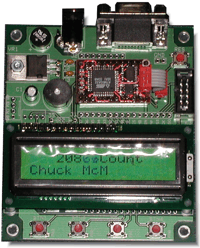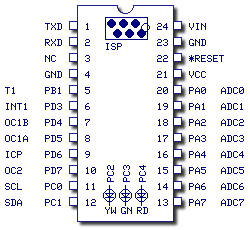The StAVeR-24M32
Chuck McManis
August 2004
Introduction
 The StAVR-24 is a complete AVR
AtMega32 processor you can plug into a BASIC
stamp socket. It is available from
Lawicell on their website, or through
ImageCraft bundled with their
C compiler. The name is a weak pun on the name 'Stamp' with the 'amp' replaced
by 'AVeR'. Frankly I think its weak, but clearly the engineers thought it was
neat-o.
The StAVR-24 is a complete AVR
AtMega32 processor you can plug into a BASIC
stamp socket. It is available from
Lawicell on their website, or through
ImageCraft bundled with their
C compiler. The name is a weak pun on the name 'Stamp' with the 'amp' replaced
by 'AVeR'. Frankly I think its weak, but clearly the engineers thought it was
neat-o.
The picture shown on the right is the StAVR chip in a socket that is on the
equivalent to the Parallax "Board
of Education" board. The difference is that the StAVR board comes some
peripherals built in, rather than plugging them into a protoboard.
 Its interesting to me the
emergence of a defacto standard for a 24 pin controller based on the BASIC Stamp
II pinout. This is a really neat thing for robotics as it makes a large number
of boards and peripherals available to a number of people. For example there are
a number of ready-build robot bases and kits that expect you to plug in a Stamp.
Its interesting to me the
emergence of a defacto standard for a 24 pin controller based on the BASIC Stamp
II pinout. This is a really neat thing for robotics as it makes a large number
of boards and peripherals available to a number of people. For example there are
a number of ready-build robot bases and kits that expect you to plug in a Stamp.
The picture on the right is borrowed from the Lawicell site. It shows the
pinout of the StaVeR-24M32 and the various uses for its pins. In partictular the
right hand side (PA0 - PA7) are 10 bit A/D converters. Very nice in robotics
applications.
What's Cool About It?
There are a number of things to warrant looking into this device. Perhaps
first and foremost, if you started your hobby robotics explorations with Basic
Stamps, then this is a good next step in terms of "brain" complexity. With 30K
or FLASH (EPROM) and 2K of SRAM, the StAVeR can host fairly sophisticated
programs written directly in a high level language like C.
On "chip" peripherals include three LEDs, one red, one green, and one blue,
that are not shared with I/O lines on the chip. Thus you can use them to
indicate states without "giving up" one of the 16 I/O lines that match up with
the BS-2 I/O pins. Additionally, the AtMega 32 series includes actual A/D
converters that are brought out to some of the chip pins, so where you would use
the "POT" command in a BASIC stamp to read voltages, on the STaVeR24 you can use
a "real" A/D converter.
Finally, the folks at Atmel have been aggressively pursuing hobbyists to get
a piece of the market that Microchip has dominated for years. One of the ways
they are doing that is by providing good tools at low cost (free for software
only tools). This includes things like an in-system programming "pod" for < $30.
When used with the StAVeR24 you have a complete AVR development system. Further,
you can do your development on Linux as GCC-AVR is fully supported. All in all,
quite a nice little package.
What's Not So Cool About It?
Access to the ISP pins is via a fairly unusual high-density 6 pin connector.
That connector and a short ribbon cable are shown in the photo above on the
right hand side of the board. Lawicell offers a 1K bootloader that lets you
program the flash using a program embedded in the first 1K of flash space, but
that both takes space away from your programs and you have to physically reset
the chip in order to "get its attention." One of the things I like about the
AVRISP and JTAGICE are that you can run them entirely remotely. No need to reach
over to your workbench and find and push a button. They've done the best they
can, but its a pain sometimes.
Perhaps a nit is the fact that the LCD on the developer board covers the
proto area. Unlike the Lab-X3, trying to install things and then debug them,
with the LCD in place will be nearly impossible. The good news is that you could
plug the StAVeR24 into your proto-board like a chip.
Summary
I've been impressed so far with the features of this simple chip and its
competitive in price with a BASIC Stamp 2. (the StAVeR is $49 from the
ImageCraft site, the BS2 is also $49 from Parallax). Its a lot faster and with a
C compiler a lot more flexible. I can easily recommend it for anyone looking to
"move on" from their Stamps to the next level of robotics.
--Chuck McManis
 The StAVR-24 is a complete AVR
AtMega32 processor you can plug into a BASIC
stamp socket. It is available from
Lawicell on their website, or through
ImageCraft bundled with their
C compiler. The name is a weak pun on the name 'Stamp' with the 'amp' replaced
by 'AVeR'. Frankly I think its weak, but clearly the engineers thought it was
neat-o.
The StAVR-24 is a complete AVR
AtMega32 processor you can plug into a BASIC
stamp socket. It is available from
Lawicell on their website, or through
ImageCraft bundled with their
C compiler. The name is a weak pun on the name 'Stamp' with the 'amp' replaced
by 'AVeR'. Frankly I think its weak, but clearly the engineers thought it was
neat-o. Its interesting to me the
emergence of a defacto standard for a 24 pin controller based on the BASIC Stamp
II pinout. This is a really neat thing for robotics as it makes a large number
of boards and peripherals available to a number of people. For example there are
a number of ready-build robot bases and kits that expect you to plug in a Stamp.
Its interesting to me the
emergence of a defacto standard for a 24 pin controller based on the BASIC Stamp
II pinout. This is a really neat thing for robotics as it makes a large number
of boards and peripherals available to a number of people. For example there are
a number of ready-build robot bases and kits that expect you to plug in a Stamp.